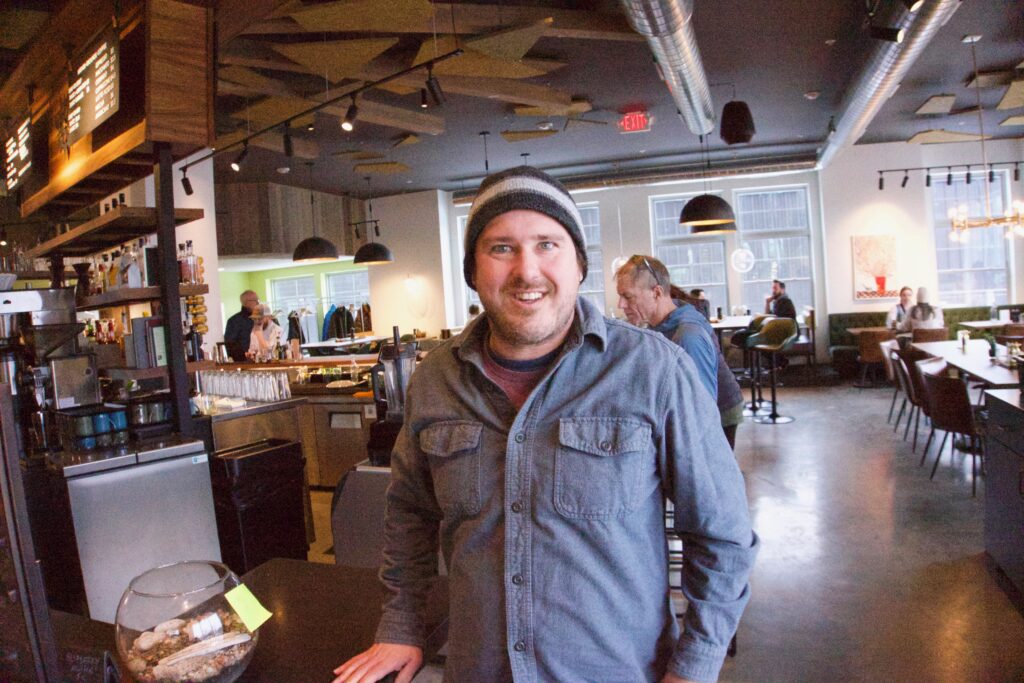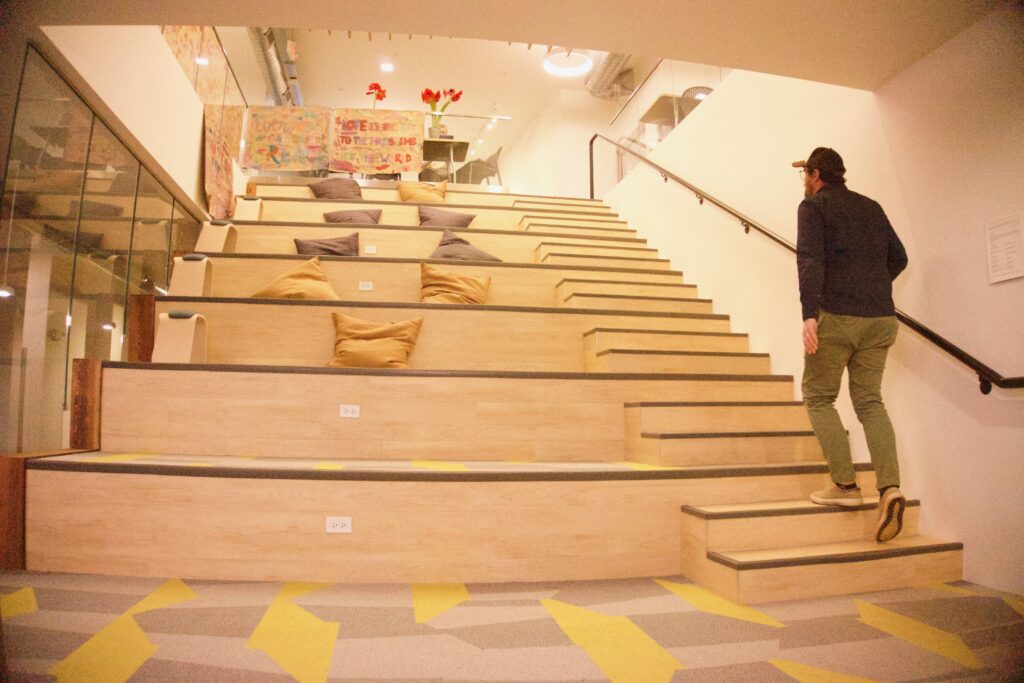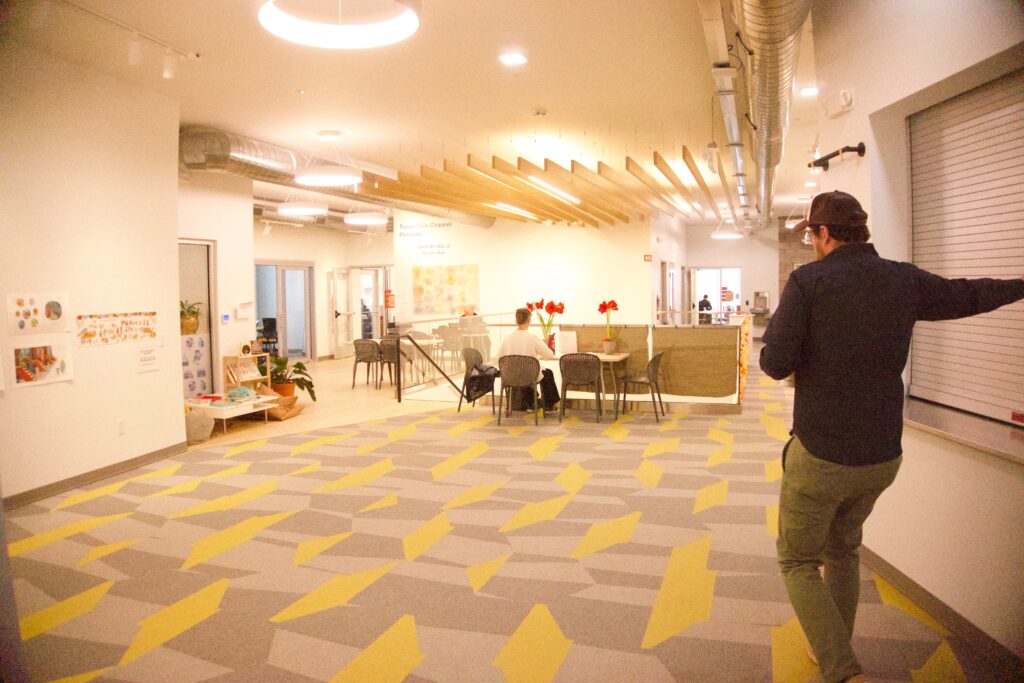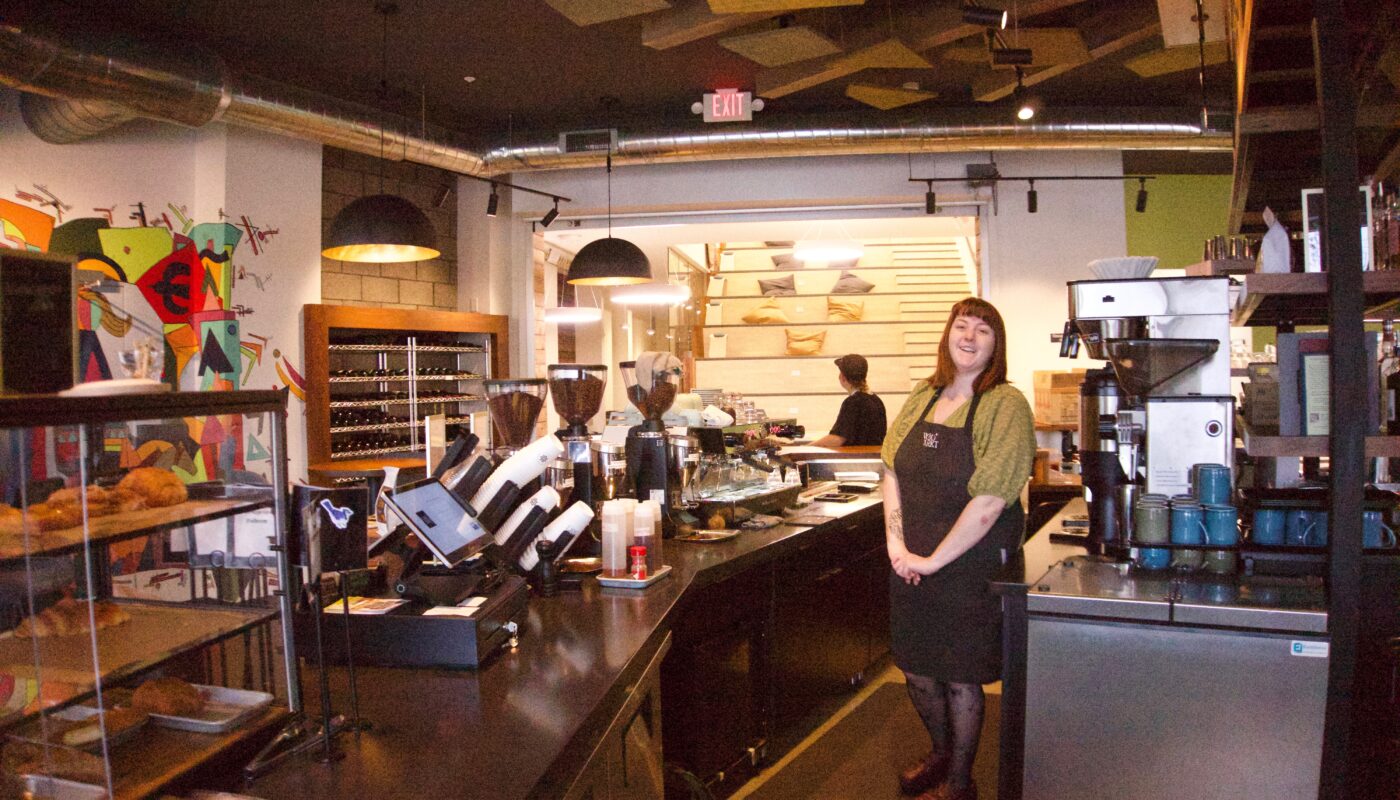
TRAVERSE CITY, MI – As owner of Higher Grounds Trading Company, Chris Treter enjoyed strong demand for his company’s coffee even as he confronted a related challenge brought on by the surging popularity of this Lake Michigan city. New hires couldn’t find affordable places to live.
“Traverse City is becoming Myrtle Beach meets Hilton Head,” said Mr. Treter. “A place catering to a population outside the region. Our workforce can’t live here anymore.”
Treter’s solution, developed with Kate Redman, a non-profit attorney, and several other similarly-challenged entrepreneurs, is Commongrounds, a $20 million, 47,000 square-foot mixed use development that opened late last year. It’s an eclectic mix of 18 affordable residences, five short-term rental units, three commercial kitchens, a coffee training center, a 150-seat performing arts center, restaurant, food market, co-working space, offices, and a Montessori preschool. All are intended to help solve shortages in the real estate market brought about by Traverse City’s increasing gentrification and soaring prices.

Just as distinctive as the design is how Ms. Redman and other project leaders developed a crowdfunding campaign that recruited nearly 500 residents to invest $1.3 million as a down payment to help finance construction and become shareholders of the project, earning up to 7 percent annually in dividends. More than 500 more residents contributed $50 each to join the project as small stakeholders.
The owners also embrace a cooperative management approach to operations. Shareholders, tenants, and apartment renters elect the project’s nine-member board of directors.
Largest of Its Kind
Commongrounds, in effect, is the latest and largest example of what developers of similar projects across the country call “community-owned cooperative real estate.” Other examples occur in Atlanta, Boston, Minneapolis, Oakland, Philadelphia, Portland, and elsewhere. Typically, the goal is to preserve the character of places disrupted by new construction and rising real estate values.
“It’s part of a robust movement for community control and affordable real estate, rather than enabling high-priced development at the whims of the market,” said Mohit Mookim, an attorney with the Sustainable Economies Law Center, a non-profit group in Oakland, CA. that helped develop the strategy.
Formulated over the last decade by public interest organizations and law firms, the cooperative strategy enables neighborhood groups to finance unconventional construction or renovation projects that mainstream lenders won’t touch.
Much of the new approach stems from a directive Congress issued to the Securities and Exchange Commission in the 2012 JOBS Act. Congress called for allowing groups to sell ownership shares in real estate through crowdfunding, and it directed the SEC to dismantle regulations that barred small “non-accredited” investors — those with a net worth of less than $1 million or making less than $200,000 a year in income — from investing like wealthy “accredited” investors had always done.
As the SEC prepared the new rule, which it issued in 2015, Michigan, California and over two dozen more states enacted their own laws to allow projects to engage non-credited investors. “Until that change 90 percent of the residents in a community couldn’t make direct investments in a real estate project,” said Chris Miller, board chairman of the National Coalition for Community Capital, a non-profit group. “Michigan allows non-accredited investors to invest up to $10,000 in a project now. That was unheard of before.”

The East Bay Permanent Real Estate Cooperative in Oakland is widely credited with being one of the first community groups to apply the community-owned cooperative concept to a neighborhood project. It raised $185,000 from a crowdfunding campaign that attracted more than 25 investors in 2019 to help finance a $1.3 million project to purchase and renovate Co-op 789, a four-unit apartment building in north Oakland. Community investors earn an annual dividend of 1.5 percent. The seven-year-old group financed the balance of the purchase through a loan with a local land trust, and two bonds supported by the city of Oakland.
East Bay Cooperative is now collaborating with 7th Street Thrives, a community group it co-founded, to purchase and revitalize three buildings and a vacant lot along 7th Street in west Oakland, a historic black business corridor. The $7 million project is financed, in part, by nearly 400 community investors who earn 1.5 percent return on their ownership shares. It’s the first phase of a long-term project to revive 7th Street as a center of economic and cultural energy through local financing to own and manage its residential and commercial spaces.
Noni Session, East Bay Real Estate Cooperative’s co-founder and director, explained that community-owned cooperative projects respond to the economic disruption caused by what she called the “standard capital pathway” of conventional development. Developers and private bankers who live and work outside the city, she said, typically ignore local residents as they pursue projects touted as “neighborhood revitalization.”
“Almost all of that overlooks every single person in a non-affluent community like west Oakland,” said Ms. Session. “Our model is economic inclusion. The goal is to reclaim our city and recapture power for how it develops.”
More Examples
Other examples are becoming more numerous. In Boston, TLee Development recruited 81 community investors to raise $142,500 as a start to building Dot Crossing, a five-story mixed use building with 29 affordable apartments and ground floor space for a bookstore on a vacant lot on Dorchester Avenue. Completed late last year, the balance for the $9.65 million project was provided by two state housing loans and the Healthy Neighborhoods Equity Fund, developed by the Conservation Law Foundation and the Massachusetts Housing Investment Corporation to provide capital for affordable mixed-use residential and commercial projects in Boston neighborhoods.
“We’re involved in 15 projects like this around Boston,” said Declan Keefe, co-founder of CoEverything, a Boston architecture and development consultancy that specializes in community-owned cooperative projects. “The focus is community ownership so that people aren’t being displaced.”
In Atlanta, The Guild — a worker-owned cooperative founded in 2015 — established the Community Stewardship Trust for local residents to buy shares and build wealth with investment income from neighborhood real estate projects. The Guild’s first project: the purchase of an abandoned 7,000-square-foot building on Dill Avenue that The Guild is expanding to 21,000 square feet for 18 units of affordable housing, a grocery store, a co-working space, and three commercial kitchens.
The $11 million project was initially financed with loans from foundations and a Community Development Financial Institution (CDFI), and a $1 million city housing bond. After the project opens later this year, The Guild anticipates paying down a portion of the loans by recruiting 400 residents to buy shares of the Community Stewardship Trust, who will earn 2 to 4 percent in projected returns from operating income and the increasing value of the project.
“Our goal is making sure that in neighborhoods that are gentrifying, the people that made these neighborhoods great get to benefit from the development that’s happening,” said Nikishka Iyengar, The Guild’s founder and director.
Principles of Community and Affordability
In Traverse City, Commongrounds was driven by some of the same principles of affordability and community oversight. Once a temperate seasonal beachfront outpost of 15,000 residents, the city added 1,000 new residents over the last decade and evolved into a busy, increasingly expensive all-season urban center.
Downtown is booming with new and expensive residential and commercial construction. A 1-bedroom apartment typically rents for over $1,900 a month while annual median individual incomes have barely nudged above $31,000. The median price for homes climbed to nearly $400,000 in February, more than twice what it was in 2010.

Joe Sarafa, a local developer and property manager, guided Mr. Treter through the details of purchasing the half-acre building site along the Boardman River, which flows through the city. Eight local residents, most of them prominent community activists, invested $550,000 to purchase the property and become the project’s first investors.
Ms. Redman, helped by volunteers, organized public meetings to decide the project’s core mission, and develop the crowdfunding strategy. They worked with city officials to adjust several zoning restrictions, such as dramatically reducing parking requirements.
Another key player is Jeff Hickman, a vice president of Coastal States Bank who lives in Traverse City, and arranged $8 million in rural business and industry loan guarantees from the U.S. Department of Agriculture. Other big investments included $3 million from the non-profit IFF, a community development lender, $1.85 million from the PACE green building program, a $1.5 million state revitalization grant, and $210,000 from Grand Traverse County to remove chemical residue from the construction site. Seven Commongrounds tenants invested $3.6 million to construct their spaces.
The finished building, with its sunlight-filled public spaces and inviting offices and residences was designed by Ray Kendra, a local architect, and is managed by a 5-member staff directed by Ms. Redman and Andrew Lutes, a musician with hospitality business experience.
“What I want to do now is work on more community-owned projects,” said Ms. Redman. “There’s interest here to develop more housing and more real estate that meets community needs.”
— Keith Schneider
A version of this article was published by The New York Times on May 13, 2024.


